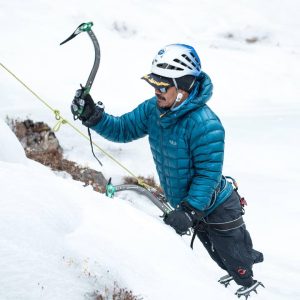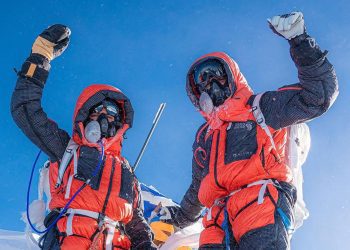From Everest, the world’s peak, May 2023 went down the annals of history as one of the remarkable achievements for Persons with Disabilities (PWDs). For the first time, within the space of five days, four PWDs made it to the summit of earth’s highest mountain at 29,031 feet – albeit only three lived to tell their stories.
The Heroes
Malaysian, Hawari Bin Hashim (Deaf and without speech); Nepalese veteran soldier Hari Buda Magar, (double above knee amputee); and American couple, Scott Lehmann and Shayna Unger (Deaf)
As I write this, one question kept looping in mind: what’s the back of the daring dos of these brave souls? Yes, fame and recognition are a part of it. But there’s more. For these winners, each implied in their own individual comments how the uncommon feats are all tied to making bold statements about the disability cause.
Martyrdom on Everest
On Tuesday, May 18, 2023, thirty-three year old Muhammad Bin Hashim joined the league of brave hearts who’d conquered earth’s highest natural peak – Mount Everest. At that moment, Hashim became only the second Deaf person (and without speech) to achieve the feat. Some seven years prior, fifty-year-old Deaf Japanese alpine skier, Satoshi Tamura had on May 21, 2016, became the first Deaf man to reach the summit.
Hashim says he’s always dreamed of reaching that intimidating summit to make a loud statement: “Living with Disability does not have to be limiting”. He hoped that his feat motivates other PWDs to believe in, and pursue their dreams and passions. Did he achieve that dream? Yes, even if only half-way.
Hashim paid the supreme price; two years of arduous training, up-close encounters with discrimination, financial hardships, and communication barriers, then the grinding climb that saw the mountaineering team slug it through the Khumbu ice falls, Western CWN, the Lhose falls and the South Col. Finally there he stood atop Everest proudly waving the flag of his home State of Penang with a big grin.
By that gesture, Hashim silently echoed the eternal motto: “Disability does not have to be limiting”. On a higher pedestal, the 33 year old’s feat stirred heightened awareness and respect for the global Deaf community and their culture.
Sadly, he didn’t live long enough to bask in the glory. He went missing on his way back from the summit on Friday, May 19 and was never found. But he will enter the history books as the first Deaf martyr of the disability cause as seen from Everest’s freezing heights.
An Astounding Feat without Feet
In a remarkable twist of fate, Hari Budha Magar became the first double above-knee amputee to conquer the world’s highest peak same day Hashim went missing. Hari, a Nepalese born Gurkha ex-soldier lost his legs while serving in Afghanistan. He set out on the expedition on Friday, April 17 – exactly 13 years since he became an amputee. Magar recalls the kind of discrimination ridden setting he grew up in:
“I grew up in Nepal…and saw how disabled people were treated in those remote villages. Many people still think that disability is a sin of previous life and you (people with disability) are the burden of the earth. I believed that myself because that’s what I saw, that’s how I grew up”.
Growing up with such limiting beliefs was a long haul for him. Fortunately, he did.
Hari’s first thought of climbing Everest began while he was yet a barefooted schoolboy walking the streets of Nepal. He planned to achieve that by 2018. It is remarkable that when in 2013 he became an amputee, he never let go the ambition to summit Everest.

The banning of amputees and blind people from climbing by the Nepalese Government temporarily put a pause to that ambition. This was done to reduce the increasing number of deaths during climbing expeditions. A resolute Hari would be a part of the successful campaign to repeal a ban that clearly impinged on the rights of PWDs.
Freezing temperatures at the base of Everest, the sight of corpses being dragged down the mountain, the absence of lower limbs, none of these could faze Hari. Recalling the motivation behind the feat, he says, “without losing my limbs, I wouldn’t be climbing Everest, and it wouldn’t even count much. Whatever happens, it happens for good”.
Hari says, “I want to return to Afghanistan, to the site where I lost my legs, so that I can say “thank you”.
And while still fresh from the feat, Hari says that his main aim for the rest of his life will be “working to bring awareness about disability”. So conquering Everest is just the starting point.
Lehmann and Unger: Seeing Beyond Doubts, Limitations and Obstacles
When the clock struck 6:00am on May 22, barely four days after fellow Deaf, Hashim made it to the pinnacle of Everest (just three days of Hari) another PWD feat was recorded.
They had braved the scare of increasing death toll and life-threatening weather conditions to reach the peak – becoming the 3rd and 4th deaf persons to do so. It’s been a 20-day-long adventure since they first met at Everest’s base camp while waiting for a clear before beginning the arduous ascent.
Scot Lehmann 31, and Shayna Unger, 33, (profoundly deaf American couples) are clearly on a mission of bridging the gap between the outdoors and the deaf community as they travel the world on speaking tours sharing their experiences as deaf mountaineers. While at it, they dispense words of wisdom gained from their adventures – sharing their dreams with their own community.

To the couple, it is seeing above and beyond themselves. “Everest is part of the broader goal to conquer all seven summits [across the world’s continents], to be the first ever deaf people to do so – inspiring the next generation of deaf kids and aspiring deaf climbers around the world.”
With the conquest of Everest, Lehmann and Unger have now stood atop four of the seven summits. Earlier, they climbed Kilimanjaro in Africa, the Aconcagua, and Denali in America’s South and North, respectively. So they are well on track to reaching their goal of setting a world record and winning a new distinction for the disability community worldwide.
Lehmann and Unger have been a couple since high school, however the joint mountaineering began in 2015 when they reached the peak of Kilimanjaro together. The more experienced Scott first fell in love with climbing in 2012 after scaling Mount Rainier in Washington DC. But there were problems – barriers to education, lack of access for deaf climbers, and communication challenges manifesting as lack of access to mountain climbing information and opportunities. There was also a dearth of deaf mentors to learn from.
But instead of letting obstacles weaken the dream, the couple developed passion to break barriers and scale through. They wrote on their website: “This [obstacles] ignited passion for making the outdoors accessible to deaf and hard of hearing communities”.
Continuing the impassioned narrative, they wrote: “till this year, only one deaf person has conquered Everest (Japan’s Satoshi Samura, May 21, 2016). Makes us wonder if the space has been inaccessible to people like us. When will the world be open to our way of communication and see it as equal? “Now is the time”, both quipped.
And Lehmann says, “with the right attitude and the right adjustments, (the outdoors) is available for Deaf and Hard of Hearing people”. “It is available for people with disabilities”.
For Deaf Climbers, Mountaineering Is Extra Hard
Challenges with visibility for communication at night, difficulty communicating with sherpas with little understanding of sign language, signing while handling an ice axe, are just some of the daunting extras deaf climbers have to contend with.
As Unger would later say, “there’s a lot of different barriers we had to go through to get to Everest so when we reached the top we felt like we had overcome the odds, we were really proud of ourselves.”
As part of preparations prior to the ascent, the couple worked with their guides to learn basic American Sign Language as well as decide on visual cues and signals to be used. This precautionary measure proved very helpful.
A Ballooning Dream
Shayna Unger and Scott Lehmann have become the first Deaf Americans to reach the top of Everest. Unger is the first Deaf woman in the world to achieve the feat. Sights are now set on conquering three more peaks to arrive the dream “seven summits of the world”. While that’s good to know, even better is the knowing that the dream goes beyond themselves.
When Lehmann talks about what he hopes the story of two Deaf adults reaching the summit of Mount Everest would mean to young, upcoming aspirers of his own community, he repeatedly uses the word “dream”. Signed in ASL as an inflating balloon that gets bigger and bigger with each emphasis, this, probably, is his way of saying the dream gets bigger with the growing ambition that each new achievement inspires in others of my community.
By sharing these stories of grit and gumption, we ignite a spark in others, inspiring courage and empowering them to pursue their dreams and ambitions head-on. Alexander writes from Lagos, Nigeria
Acknowledgment
Special thanks to my friend, Peter Torres Fremlin whose impressive compendium of disability news and stories in the Disability Debrief newsletter keeps providing inspiration and opening up new perspectives on the subject of disability blogging.

